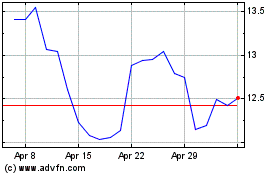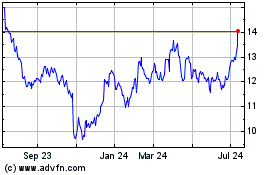By Christina Rogers in Detroit and Trefor Moss in Shanghai
Ford Motor Co.'s big bet on China, the world's biggest auto
market, has yet to pay off.
The auto maker began a $5 billion investment plan in the country
in 2006, building more models locally, adding dealerships and
expanding factory space in a bid to catch up with rivals such as
General Motors Co. and Volkswagen AG.
After an initial boost, Ford's car sales are stalling. In 2014,
the auto maker ranked as the sixth-largest by passenger-car sales
in China. It plunged to 18th place in the first three months of
this year, according to research firm LMC Automotive. Analysts
attribute the drop largely to Ford's failure to innovate and
customize its cars for technology-loving Chinese customers.
Ford has long sold cars in China, where it has several assembly
factories and joint ventures. As Ford added more models and
expanded the number of dealerships, the country generated profits
for Ford.
But Ford's China business posted a loss in the first quarter of
2018, as the company launched a new effort to turn its operations
in the country around. While the Chinese joint-venture operations
contributed $138 million to Ford's quarterly profit, that gain was
more than offset by engineering costs for future products aimed at
the local market, Ford's finance chief said during an April
earnings call.
Ford's challenges in China add to the tasks facing Chief
Executive Jim Hackett, who has embarked on an ambitious
cost-cutting program and has to improve margins in Ford's core U.S.
business, even as the auto maker plays catch-up with rivals on
electric and autonomous vehicle technology.
Further, trade tensions between the U.S. and China are
threatening to create market uncertainty at a time when Ford is
getting ready to spend even more in China, including a plan to
import Chinese-built Focus compact cars to the U.S. starting next
year.
Chinese customs authorities have been "slow walking" some Ford
imports for a few weeks, a person familiar with the matter said on
Wednesday. Some Ford cars awaiting import into the country have
been held up by unusually lengthy port inspections and other red
tape, the person said.
Ford executives say a barrage of new China-focused products--50
launches are due by 2025--will spark a turnaround, but some local
sales staff are dubious.
"There is a saying: Distant water cannot slake an immediate
thirst," said Shang Yongwei, a Ford salesman in Dalian, in northern
China. "Ford does not understand Chinese consumers, who love new
things."
Ford was also the most complained-about auto maker in China last
year according to the China Consumers Association, logging 850
complaints for poor customer service and quality problems.
Tian Suoli, a construction manager in the central Chinese city
of Xi'an, said he had been a loyal Ford customer for the last
decade. But after spending $1,600 to fix the cooling system on his
2013 Ford Kuga SUV--and then failing to get a refund after Ford
issued a recall for the same problem--he said he would never buy
another Ford car.
"I was furious," Mr. Tian said. "I wanted to smash the car."
A Ford spokesman said the company has made improvements on the
quality front, pointing to Ford's recent rise in J.D. Power China's
2017 initial quality study to 19th spot--up from 33rd the year
before.
Ford launched its $5 billion plan to expand in China under
former CEO Alan Mulally. The move, billed at the time as Ford's
largest industrial expansion in at least 50 years, was accompanied
by a product blitz that added more models to Ford's Chinese
lineup.
Between 2012 and 2015, Ford's market share in China climbed to
nearly 5%. Its joint-venture profit margins rose to a high of 15.6%
in 2015.
But Ford's global-car approach--one vehicle to be sold in all
markets world-wide--was limiting in China, where tastes differ from
the U.S. and Europe, and made its cars more expensive to produce
than the low-cost models churned out by competitors.
Much of the engineering work was being done outside the country,
distancing Ford's decision makers from local customers. As a
result, many of its vehicles today lack features that appeal to
Chinese buyers, such as leading fuel economy and internet
connectivity, analysts say.
For instance, an entry-level Ford EcoSport SUV, costing roughly
$12,600, gets worse gas mileage and offers fewer tech features than
the $10,900 Baojun 510 SUV, a newer vehicle built by GM and Chinese
partner SAIC Motor Corp.
"They haven't exactly pushed the envelope with styling for the
market," said Janet Lewis, Macquarie Capital Research's managing
director of equity research. "They run the risk of losing out to
up-and-coming local brands."
Ford executives say new models planned for China, including a
new Kuga SUV unveiled at the Beijing Auto Show in April that runs
software applications provided by internet giant Alibaba Group
Holding Ltd., should boost sales. They also point to investments in
local research and development, and say product delivery times have
been cut by a fifth to help keep pace with the fast-moving China
market.
"We're at the absolute trough of our product cycle in China,"
said Ford's Global Markets chief, Jim Farley, during the company's
first-quarter earnings call. "Over the next 24 months, we will
completely revitalize our lineup."
Fanfan Wang in Beijing contributed to this article
Write to Christina Rogers at christina.rogers@wsj.com and Trefor
Moss at Trefor.Moss@wsj.com
(END) Dow Jones Newswires
May 10, 2018 07:14 ET (11:14 GMT)
Copyright (c) 2018 Dow Jones & Company, Inc.
Ford Motor (NYSE:F)
Historical Stock Chart
From Mar 2024 to Apr 2024

Ford Motor (NYSE:F)
Historical Stock Chart
From Apr 2023 to Apr 2024
